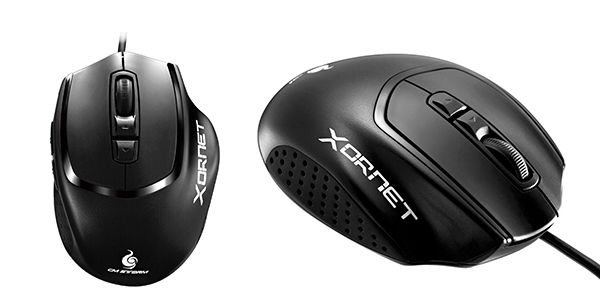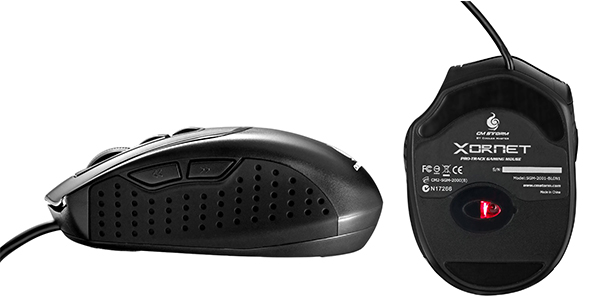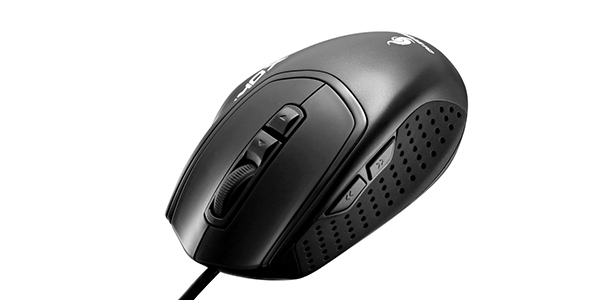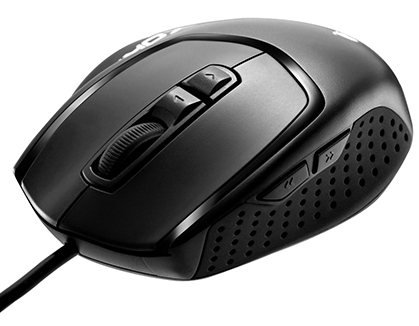Tom's Guide Verdict
The Xornet offers just enough to please FPS gamers on the go without compromising many important features.
Pros
- +
Comfortable design for claw players
- +
Very reasonable price
- +
Smart button placement
Cons
- -
No thumb rest
- -
2,000 DPI cap is low
- -
Not much use outside midlevel FPS play
Why you can trust Tom's Guide
The CM Storm Xornet ($29.99) is a budget gaming mouse intended for first-person shooter (FPS) players, and for what it is, it performs very well. Users who need a comprehensive gaming mouse may need to look elsewhere, but the Xornet offers just enough to please FPS gamers on the go without compromising many important features.
Design

The Xornet is a small mouse, although it should work fine for any hand size. Unlike all-purpose gaming mice, which generally allow either a palm or claw grip, the Xornet sports a shortened body that supports only claw. This means that it has an abbreviated palm rest that rises very low off the surface. Palm users may find this design insufferable, but claw users should find it perfectly natural.
One design choice that claw users may find strange, however, is the lack of a thumb rest. The Xornet has textured pads on either side for the thumb and pinky, but offers a rest for the ring finger. This design is more common of palm-style massively multiplayer online (MMO) gaming mice, like the Logitech G600 and, while not uncomfortable, seems out of place on a claw mouse.
MORE: Best Gaming Mice
Beyond that, the mouse has a left button and a right button, a clickable scroll wheel, two programmable thumb buttons and two DPI adjustment buttons in the center. The buttons are in a convenient layout, and what they lack in distinctness, they make up for with spacing. The dots-per-inch (DPI) sensitivity buttons, for example, feel almost identical, but are large and close enough to make it easy to tell them apart.
The thumb buttons also feel somewhat similar, but since there are only two of them, we had no trouble telling them apart during our tests. Aside from the unusual ring-finger rest, the Xornet uses a sensible design for its intended audience.
Features

The Xornet is pretty light when it comes to frills. There's no specialized software, no profiles and no customizable DPI.
This isn't necessarily a bad thing. A lack of software means one fewer program to run in the background alongside a demanding game. Furthermore, while assigning the two thumb buttons to each game individually takes some time, it also gives a user a theoretically infinite number of "profiles" to play with.
On the flip side, you only get to program the two thumb buttons, as the DPI buttons do only one thing. The Xornet has three DPI settings: 500, 1,000 and 2,000, and aside from feel, there's no way to tell which is which.
Since there are only three settings, the buttons don't get too confusing, but the maximum DPI may still be too low for many players. Most modern gaming mice range up to 8,200 DPI. While it's seldom beneficial to go that high, 2,400 is usually a comfortable base setting for FPS. Twitchy players will find even 2,000 rather slow by comparison.
The fact that the Xornet is an optical mouse may be a suitable trade-off, however. Most gaming mice are laser, rather than optical. In our experience, we found the difference between the two styles to be negligible, but some gamers swear by optical peripherals, and this one is as good as any.
Performance
In terms of games, the Xornet generally performed as well as any of its competition. The mouse's inability to exceed 2,000 DPI did work against it in extremely high-octane situations, but otherwise, the Xornet was responsive and accurate for our standard roster of games: "BioShock Infinite," "StarCraft II," "Batman: Arkham City" and "World of Warcraft."
MORE: Best Gaming Keyboards
We found that our standard FPS — "BioShock Infinite" — and the Xornet were a good match. While more buttons would have been nice, we were able to assign two of our most important skills (crouch and use) to the thumb buttons, which freed up our left hand considerably.
That said, the Xornet might not hold up so well in competitive FPS titles like "Call of Duty," "Battlefield" or "Team Fortress 2." At high levels of play, surveying your surroundings in a split second is vital to survival, and the Xornet takes slightly longer than that.
The mouse was also not terribly useful for the other three titles. "StarCraft II," for example, does not allow players to map some of its most useful features (like the attack-move command) to mouse thumb buttons without profile software. The mouse was perfectly competent, but offered no special advantage.
Likewise, the two extra buttons helped in "Arkham City" and "World of Warcraft," but given the vast number of extra commands available in each title, a controller or a more complex mouse would have served better.
The Xornet has no liftoff range whatsoever, but it does have extremely precise Z-axis tracking. Picking up the mouse and placing it back down on a surface caused no appreciable cursor movement.
Verdict

The best word to describe the Xornet is "unassuming." It's not the best or most ambitious mouse on the market, but it's also hard to find any major faults with it. That said, palm-grip players, multigenre aficionados and tournament-grade FPS diehards can probably pass on the Xornet.
If you want a good, portable FPS mouse for single-player campaigns or casual competition, $29 is hardly too much to ask. The Xornet is simple, but there is a certain elegance in its simplicity.
Specs:
Laser Depth: 4 mm
DPI: 50 – 8,200
Size: 102 x 70 x 38 mm
Weight: 140 g
Connection: Wired
Grip Type: Claw
Follow Marshall Honorof @marshallhonorof and on Google+. Follow us @tomsguide, on Facebook and on Google+.
Marshall Honorof is a senior editor for Tom's Guide, overseeing the site's coverage of gaming hardware and software. He comes from a science writing background, having studied paleomammalogy, biological anthropology, and the history of science and technology. After hours, you can find him practicing taekwondo or doing deep dives on classic sci-fi.
-
MultiverseAFK Um... yeah, this article could have been done better to be honest. Claiming that it does not suit competitive FPS games because of it's limit of 200 DPI isn't a really good reason, considering that most pro Counterstrike players use 400-500 DPI. Some use more, but the vast majority stay at lower DPI ranges. They also probably don't mind the lack of buttons considering how many of them use Razer Deathadders, Logitech G9s, and other mice with as few buttons as the Xornet.Reply
What's with the specs at the end? 50-8200 DPI, when the rest of the article clearly says 2000 DPI?
I'm sorry if I sound rude, but this article was not very well done. I love TomsHardware for their articles, mainly because they try to be as unbiased as possible by looking at the products they review from multiple different perspectives, but this TomsGuide article seems to give the mouse's low price as the only justification for it's lack of buttons. Some people, really don't need or want that many buttons.


